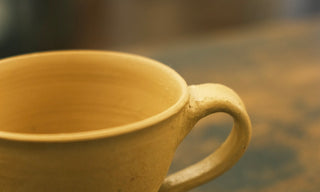In the world of ceramics, the question of wall thickness in works thrown on the potter's wheel marks a fascinating interface between technical mastery and aesthetic intention. Traditionally, the ability to achieve uniformly thin wall thicknesses with remarkable precision is considered a testament to craftsmanship. But does this criterion deserve the status of a quality feature? Or does this reveal a deeper dimension of artistic expression that goes beyond mere mastery of materials?
The craftsmanship, especially in the challenge of thinly throwing several pieces in precise repetition, is beyond question. It requires not only a strong feel for the material and body control, but also many years of experience. However, to see this skill as the sole quality criterion would be an inadmissible narrowing of the field of vision.
Globally recognized ceramists, whose work features robust, thicker-walled designs, challenge the traditional view. Her works are valued not despite but because of their material characteristics. The thickness of the wall often serves as a conscious stylistic device that contributes just as much to the uniqueness of the object as the shape or the glaze.
The function as a benchmark
In functional ceramics, a certain wall thickness can also have practical reasons. Let's take the example of the thick-walled espresso cups from southern Italy: their popularity is based not only on aesthetic preferences, but also on their functional ability to retain the heat of the coffee. Here, wall thickness reveals itself to be a thoughtful decision that takes both practical and sensory qualities into account. At the same time, the example shows that the requirements for a ceramic object are diverse and go beyond purely visual characteristics.
The same applies to objects where excessive wall thickness would be undesirable, such as water jugs, which might otherwise be too heavy to hold. The balance between aesthetics, feel and functionality plays a central role here. The decision for a certain wall thickness is therefore always a decision about how the object should be experienced and used.
Expressiveness and intention
Rather than a question of wall thickness, the quality of a ceramic object as a reflection of the artistic intention. It's about the work's ability to communicate with the viewer, tell a story or evoke an emotion. A rustically crafted, thick-walled jug can be just as much an expression of masterful ceramic art as a finely crafted, thin-walled vase - provided it fills its intended role and speaks to the viewer on a deeper level.
Conclusion: A plea for diversity
To view wall thickness as an exclusive quality feature would not do justice to the complexity of ceramic craftsmanship. It is one aspect among many that is put into the service of the artistic vision. True artistry is revealed not just in the technical mastery of the material, but in the ability to go beyond the material and create something that touches, fascinates and stimulates thought.
In a time characterized by fast-paced and superficiality, ceramics reminds us of the value of handwork, patience and dedication. Every piece, whether thin or thick

